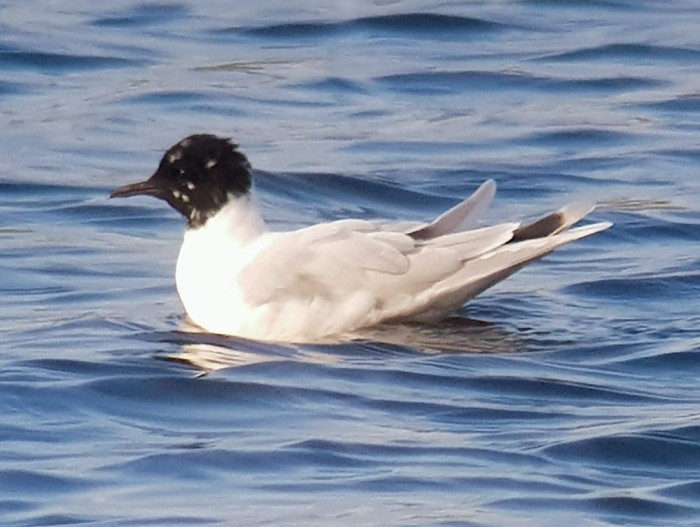The continuing easterlies at last delivered and a veritable windfall of migrants kicked off the week from day one, with a cornucopian rush of Little Gulls taking pole position in the proceedings. Waders, too, were prolific, including a Dotterel on the Cambridgeshire border, which served to round the week off nicely.
New arrivals of standard summer visitors were, however, down to the barest minimum.

Wildfowl numbers, too, were unsurprisingly low, with 24th seeing three Garganeys at Thrapston GP plus a drake at Stanwick GP, while another drake visited Summer Leys LNR on 28th. Last week’s drake Red-crested Pochard remained on the fishing lake at Wicksteed Park, Kettering, on the latter date but there was no sign this week of Ringstead GP’s long-staying female Ring-necked Duck, which now appears to have departed.
The same cannot be said, though, for the Glossy Ibis, which completed another full week at Stanwick, where it has now notched up two full months on site.
The eight Cattle Egrets remained at Stanwick on 23rd, dwindling to six by 28th and one was between Summer Leys and Great Doddington on the first of these two dates with, presumably, the same individual paying a visit to the reserve proper on the latter date, before moving back out to Dod. Great Egrets, during the period were limited to site maxima of four at Stanwick on 23rd and singles at Ditchford GP on 25th-27th, Hollowell Res on 25th, Fawsley Park Lakes on 26th and Summer Leys on 28th.
Raptor numbers were down on last week, as well as being limited to the same two species – Osprey and Marsh Harrier – with singles of the former at Summer Leys on 24th and Hollowell on 29th and of the latter over the reedbed at Stortons GP on 23rd.
Heading up the cast of this week’s waders was a not too shabby male Dotterel, found in a pea field at Hemington on the last day of the period. For most observers it kept its distance and was cloaked in heat haze. Over the years, the pea and bean fields in this area have produced five out of the county’s eleven records to date (see here for details).

This week also saw the first Grey Plover of the year arrive at Stanwick on the evening of 23rd, remaining only until early the following morning. Whimbrels continued to trickle through in small numbers, which included three at Clifford Hill GP on 26th and singles at Summer Leys on 24th, 25th and 28th, at adjacent Earls Barton GP on 25th and 28th and at Stanwick on 29th.
Bar-tailed Godwits were the order of the day on 23rd, when a not insignificant rush produced a flock of thirteen flying north-east over Byfield, two or three at Clifford Hill GP and singles at DIRFT 3, Earls Barton, Stanwick and Summer Leys.

More followed, with further singles at Clifford Hill on 29th, Summer Leys on 24th-25th and 27th and at nearby Hardwater Lake (Earls Barton GP) on 26th-27th, the later keeping close company with the week’s only Black-tailed Godwit.

Summer Leys continued to hang on to one or two Ruffs throughout the period, while the ‘magic 23rd’ delivered five Sanderlings to the reserve, followed by one the next day and another at Earls Barton’s New Workings (North) on 25th.

Keeping the stars and stripes flying, a residual Jack Snipe remained at Hollowell throughout the week, while the first true migrant (we believe) Wood Sandpiper hit Summer Leys briefly on 28th. Greenshanks continued to move through, with two at DIRFT 3 on 23rd and one on 24th, one visited adjacent Lilbourne Meadows NR on the latter date, one appeared at Ditchford on 26th and one was at Summer Leys on 28th-29th.

As far as gulls were concerned, those of the smaller persuasion had the stage all to themselves this week – and what a performance they gave! Yes, Little Gulls barrelled in on the first day of the period and by the end of it, at least thirty-two were present together at Summer Leys. Elsewhere numbers were none too shoddy, either, with 23rd also seeing thirteen at Clifford Hill GP, six at Daventry CP, five at Pitsford Res and one at Boddington Res. Numbers had dropped by the following day, when three were found at Thrapston GP and one was at Summer Leys, while 25th saw single adults at Hollowell and Stanwick, two adults were at Pitsford on 26th and a rather obliging flock of seven put on a fine show, up close and personal, at Stanwick on 29th.


Unsurprisingly, more Arctic Terns came through – albeit in small numbers – including two or three at Summer Leys on 25th, when two were also at Boddington and Stanwick. Two were again reported from Boddington the following day, when four were at Stanwick on 27th and one paid the briefest of visits to Stanford on 28th.

Again, it wasn’t a particularly eventful week for passerines, which were limited to three species and, once more, included last week’s (and the week before’s) spill-over Ring Ouzels at Honey Hill, where single males were present on 23rd-24th and 28th-29th and a male and female were also seen on 27th. Last week’s male, was still at West Farndon on 23rd-24th and females were seen between Great Doddington and Summer Leys on 27th and at Harrington AF on 26th-29th.

Single male Common Redstarts were also reported at the latter site on 24th and 29th.

This week’s Northern Wheatears maxed out at seven on Willowbrook Industrial Estate (Corby) on 29th but elsewhere, numbers were restricted to three or four at Harrington on 26th-29th, two near Piddington on 26th and singles at Boddington Res on 26th-27th, Summer Leys on 28th and at Clifford Hill GP and Pitsford Res on 29th.







































